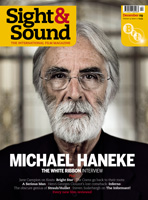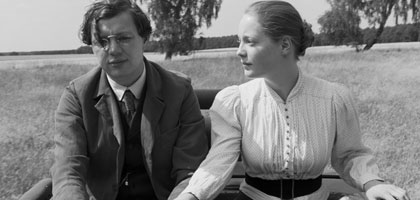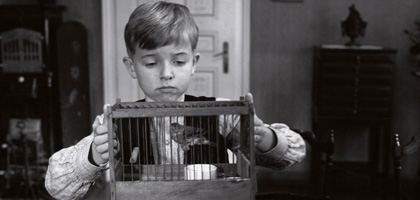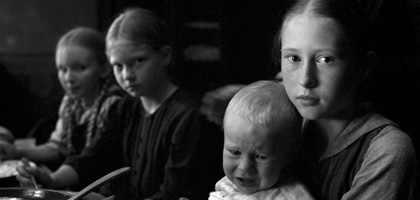Primary navigation


Michael Haneke’s Palme d’Or-winner ‘The White Ribbon’ is a tale of cruelty set in a north German village in 1913. Despite its monochrome austerity, Catherine Wheatley sees hints of a new softness in the director’s work
"Have you any pride? You want to see how far you can go? My God, why don't you just give up?" So barks one character to his lover in Michael Haneke's The White Ribbon as he tries, crushingly, to end a relationship by humiliating her into leaving him. It's a question one might equally beg of audiences paying to see the latest film from the renowned and sometimes reviled Austrian director. Repeatedly lambasted in the press for a didactic and punitive approach to his audiences that can suggest a contempt for society and spectator alike, Haneke is hardly a crowd pleaser. Indeed, like the callous doctor who utters the above lines, he has repeatedly asked his audiences why they don't just walk out. Yet as the evidence - the enduring popularity of 2005's Hidden, the fast selling-out retrospectives of his early work at the Paris Cinémathèque and London's Curzon cinemas this autumn, and of course the film-maker's long-overdue Palme d'Or win at Cannes this year - suggests, audiences are far from giving up on Haneke. Little wonder UK distributors Artificial Eye are expecting great things from The White Ribbon.
On first glance his new film might appear to be a tough sell. Haneke's black-and-white morality, which has been accused of leaving little room for shades of grey, seems to have found its perfect formal expression in this monochrome period tale, Christian Berger's crisp, cold photography echoing the ascetic existence of the residents of a German village in the months preceding World War One. The director's first use of voiceover narration in a feature film underlines this archaic aspect, putting one in mind of a range of literary ancestors, from Kafka to Handke through Brecht and, perhaps most resonantly, Friedrich Dürrenmatt, whose 1956 play The Visit (Der Besuch der alten Dame) has striking overlaps with The White Ribbon, concerned as they both are with the invidious dynamics of small towns populated by boorish bourgeois residents who go only by their titles - the Pastor, the Baron, the Doctor, the School-teacher. In the case of Haneke's film, moreover, there's a vast cast of characters who offer little room for identification or even, at times, understanding.
In this regard, it makes sense that The White Ribbon, which runs 143 minutes, was originally planned as a three-part television serial; in its epic scope and pastoral period setting there are shades of Edgar Reitz's celebrated Heimat. But it is with Haneke's early work for Austrian television channel ORF that it has most in common. The mysterious, fable-like atmosphere recalls the director's adaptations of Joseph Roth (Die Rebellion / The Rebellion, 1993) and Peter Rosei (Wer war Edgar Allan? / Who Was Edgar Allan?, 1984), as well as his celebrated version of Kafka's The Castle (Das Schloss, 1997), just released in the UK on DVD, while the sprawling narrative, tracing the passage of societal maladies through subsequent generations, has much in common with his 1979 two-parter Lemminge (Lemmings). Making a return to German-language film-making with The White Ribbon, Haneke also revisits the company of actors familiar from his early days of film-making. Faces such as those of Branko Samarovski (71 Fragments of a Chronology of Chance (1995), The Castle, Time of the Wolf) and Susanne Lothar (The Castle, Funny Games, The Piano Teacher) seem to emerge from out of the past.

Like the television work, too, The White Ribbon steps back from the aggression towards the audience that has often characterised Haneke's later work. Gone is the direct audience address of Funny Games; gone the shock tactics of Hidden and the provocative explicitness of The Piano Teacher. Gone too is the self-reflexive and self-regarding fascination with film-viewing and its variants that marked Benny's Video; in fact, The White Ribbon is the first of Haneke's cinematic releases not to feature a television screen somewhere in its midst.
Stylistically, it's a longer, more even-paced film than anything he has done previously, lacking the generic whip that drove the spectators of earlier works onwards through the narrative. Admittedly, the elements of a whodunit plot are notionally in place: the question of who is responsible for the suffering we witness reverberates throughout (as it does through Haneke's oeuvre), but the film takes its time investigating this, digressing along the way. By contrast with the urgent time spans of Funny Games (12 hours), Hidden (a week) and The Piano Teacher (which hurtles over a period of about a month towards its climatic concert), The White Ribbon unfurls alongside the sensuously evoked passing of the seasons, as winter turns to summer and back to winter, while snows thaw and cabbages poke through the hard, hot ground. Meanwhile the film's more sinister events - a malicious attack on the town doctor, the death of a farmhand, the kidnap and torture of two small boys - are interwoven with the delicate progression of a relationship between the narrator's younger self (the School-teacher is the closest thing the film offers to a protagonist) and a broad-faced and buxom young nanny, which allows an unexpected and touching tenderness to enter Haneke's cinematic universe.
One wonders if the influence of script consultant Jean-Claude Carrière might have something to do with this. Most famous for the scripts he wrote with Luis Buñuel, the veteran French writer in his time has been no less excoriating of Europe's middle classes than Haneke himself, but in films such as The Discreet Charm of the Bourgeoisie (1972) Carrière teased his victims with a wry twinkle in his eye. Some of his softer humour seems to have slipped into The White Ribbon's screenplay. If the film's world is, as one character puts it, "dominated by malice, envy, apathy and brutality", goodness, self-sacrifice and love are also to be found here, not only in the burgeoning, bumbling courtship between two young lovers, but in the fierce filial bond between a son and his mother, the tragic mourning of a man for his deceased wife, and the vision of a wide-eyed boy offering an injured sparrow to his indifferent father as a replacement for the prized parakeet put to death by his malicious sibling.
Youthful menaces
In these twin avian sacrifices - one bird literally spread-eagled, crucified as a gesture of revenge against a puritanical and ruthless patriarch (who marks his children with the titular ribbon as a badge of their shame), the other extended in an open palm as a gesture of consolation and comfort to Papa - the stakes of The White Ribbon are perhaps most openly visible. The implication of Haneke's films has arguably always been that our children will rise up against us - one need only think of the adolescent antagonists of Funny Games and Benny's Video, the youthful menaces haunting 71 Fragments of a Chronology of Chance and Code Unknown. In The Piano Teacher, the anti-heroine Erika's central relationship is not with her would-be paramour but with her overbearing mother, whom Erika beats and embraces by turns. And of course there is that final, soundless shot in Hidden, which suggests a world of possibilities about how the sins of the father may be visited on the son. But nowhere is this terrible possibility made more explicit than in The White Ribbon, whose frames are filled with the faces of children - the only characters whose names we ever know.

It may be the Schoolteacher who guides us through this tale, but it is from the children's perspective that we view events, the camera hovering at the level of their eye-lines. One charming scene turned hideous sees the Doctor's tiny son, whose mother has recently died, stumbling downstairs in search of his father and older sister - or rather it doesn't see: shrouded in darkness like the child himself, we struggle to make out shapes in the blackness. It is only when he opens a door and emerges blinking into a starkly lit room that the image becomes clear, and we share his confusion and disorientation at finding father and sister in an unusual and awkward embrace - one which hints at something altogether more troubling than the ear-piercing the pair claim is taking place. The incident is one of several in which Haneke relies on point of view to an extent unseen since Time of the Wolf, in which the narrative also revolved in no small measure around the plight of children, this time in the wake of an unspecified disaster.
As easy as it is to read The White Ribbon as a paranoid adult fantasy in the vein of The Midwich Cuckoos, the feeling lingers that the village's young are as much victims as perpetrators. As the film closes, with a series of tableaux of village life set to choral music, a feeling solidifies that the brutal acts which have punctuated the action are not, as the Pastor would have it, the actions of "a sick person"; rather that the guilt is collective, and that the children's rebellion against us is the inevitable consequence of our own actions.
It is telling that among the youngsters, three alone stand out as unblemishedly innocent: the two smallest boys, whose purity we fear is not long for this world (in fact we may have witnessed the inevitable fall of the Doctor's son with that shocking emergence into the light); and the Midwife's son, Karli. A Down's syndrome sufferer who will never truly grow up, Karli is the epitome of the incorruptible innocent - and so there is no place for him in The White Ribbon's world. Like the Schoolteacher, whose attempts to expose the frightening side of the community's life lead to his expulsion, Karli must be disposed of. His bellows of pain when, beaten and blinded, he lies dying in his bed prove the film's most arduous ordeal.
Love, innocence and hope creep into Haneke's moral universe - only to be crushed. The film's soundtrack of wailing babies and humming flies - aural motifs of new life and death - serves as a constant reminder that the cycle is infinite. Well might we ask: "My God, why don't we just give up?" And yet, as Haneke surely knows only too well, it's a question that proves bafflingly hard to answer.
A Haneke retrospective plays until 30 November at BFI Southbank, London. The ten-DVD box set ‘The Essential Michael Haneke' is out now
Secrets, lies and videotape: Catherine Wheatley on Michael Haneke's Hidden (February 2006)
The Piano Teacher reviewed by Tony Rayns (November 2001)
Code Unknown reviewed by Richard Falcon (May 2001)